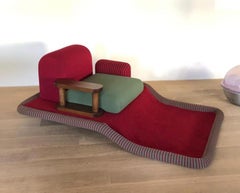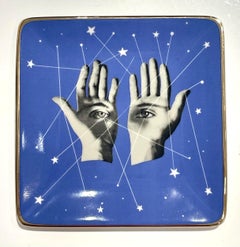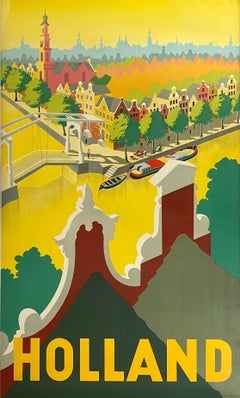Ettore Sottsass Art
An architect, industrial designer, philosopher and provocateur, Ettore Sottsass led a revolution in the aesthetics and technology of modern design in the late 20th century.
Sottsass was the oldest member of the Memphis Group — a design collective, formed in Milan in 1980, whose irreverent, spirited members included Alessandro Mendini, Michele de Lucchi, Michael Graves and Shiro Kuramata. All had grown disillusioned by the staid, black-and-brown “corporatized” modernism that had become endemic in the 1970s. Memphis (the name stemmed from the title of a Bob Dylan song) countered with bold, brash, colorful, yet quirkily minimal designs for furniture, glassware, ceramics and metalwork. They mocked high-status by building furniture with inexpensive materials such as plastic laminates, decorated to resemble exotic finishes such as animal skins. Their work was both functional and — as intended — shocking. Even as it preceded the Memphis Group's formal launch, Sottsass's iconic Ultrafragola mirror — in its conspicuously curved plastic shell and radical pops of pink neon — embodies many of the collective's postmodern ideals.
Sottsass's most-recognized designs appeared in the first Memphis collection, issued in 1981 — notably the multihued, angular Carlton room divider and Casablanca bookcase. As pieces on 1stDibs demonstrate, however, Sottsass is at his most imaginative and expressive in smaller, secondary furnishings such as lamps and chandeliers, and in table pieces and glassware that have playful and sculptural qualities.
It was as an artist that Ettore Sottsass was celebrated in his life, in exhibitions at the Los Angeles County Museum of Art, in 2006, and the Philadelphia Museum of Art a year later. Even then Sottsass’s work prompted critical debate. And for a man whose greatest pleasure was in astonishing, delighting and ruffling feathers, perhaps there was no greater accolade. That the work remains so revolutionary and bold — that it breaks with convention so sharply it will never be considered mainstream — is a testament to his genius.
1960s Bauhaus Ettore Sottsass Art
Wood
1970s Ettore Sottsass Art
Wood
Late 20th Century Post-Modern Ettore Sottsass Art
Lithograph
2010s Bauhaus Ettore Sottsass Art
Metal
1940s Post-Modern Ettore Sottsass Art
Lithograph
1970s Post-Modern Ettore Sottsass Art
Lithograph
21st Century and Contemporary Post-Modern Ettore Sottsass Art
Lithograph
21st Century and Contemporary Art Deco Ettore Sottsass Art
Stainless Steel
1960s Abstract Geometric Ettore Sottsass Art
Metal
21st Century and Contemporary Post-Modern Ettore Sottsass Art
Lithograph
Mid-20th Century Bauhaus Ettore Sottsass Art
Birch
1980s Post-Modern Ettore Sottsass Art
Lithograph
21st Century and Contemporary Art Deco Ettore Sottsass Art
Steel
21st Century and Contemporary Art Deco Ettore Sottsass Art
Metal
21st Century and Contemporary Post-Modern Ettore Sottsass Art
Lithograph
1970s Ettore Sottsass Art
Wood
Ettore Sottsass art for sale on 1stDibs.
Artists Similar to Ettore Sottsass
- What did Ettore Sottsass do?1 Answer1stDibs ExpertMarch 22, 2022Ettore Sottsass was an architect and designer. He founded the Memphis Group, a collective of designers active from 1981 to 1987. The Ultrafragola mirror is one of his most well-known designs. On 1stDibs, you can shop a variety of Ettore Sottsass furniture.
- Where is Ettore Sottsass from?1 Answer1stDibs ExpertApril 5, 2022Ettore Sottsass was from Innsbruck, Austria. He was born there on September 14, 1917, but he moved to Turin, Italy, as a child. The Italian architect and designer died in Milan, Italy, on December 31, 2007. You'll find a variety of Ettore Sottsass furniture and decorative objects on 1stDibs.
- What inspired Ettore Sottsass?1 Answer1stDibs ExpertMarch 22, 2022Ettore Sottsass was inspired by many things, including pop culture, travel and various cultures from around the world. His primary objective of his work was to bring out the deeper beauty of whatever he created. On 1stDibs, shop a collection of Ettore Sottsass furniture.
- Why is Ettore Sottsass famous?1 Answer1stDibs ExpertFebruary 13, 2024Ettore Sottsass is famous for his work as an architect and an industrial designer, which spurred a revolution in the aesthetics and technology of modern design in the late 20th century. He was the oldest member of the Memphis Group, a design collective formed in Milan in 1980. Having grown disillusioned by the staid, black-and-brown corporatized modernism that had become endemic in the 1970s, the Memphis Group produced bold, brash, colorful, yet quirkily minimal designs for furniture, glassware, ceramics and metalwork. They mocked high status by building furniture with inexpensive materials, such as plastic laminates, decorated to resemble exotic finishes like animal skins. Other than his Ultrafragola mirror (1970), Sottsass's most-recognized designs appeared in the first Memphis collection, issued in 1981. They include the multihued, angular Carlton room divider and Casablanca bookcase. Shop a diverse assortment of Ettore Sotsass furniture and decorative objects on 1stDibs.
- What did Ettore Sottsass design?1 Answer1stDibs ExpertApril 5, 2022Ettore Sottsass was a famous 20th century architect and designer known for his work in furniture, lighting, jewelry and more, as well as from his work in designing buildings. He was Italian, though he was born in Austria, and lived from 1917 to 2007. Shop a range of Ettore Sottsass pieces on 1stDibs.
- 1stDibs ExpertMarch 22, 2022To pronounce Ettore Sottsass, say "AY-tore-ee SOAT-sas." The second syllable of the designer's surname sounds similar to the word “sauce” but with a shorter, clipped vowel. On 1stDibs, find a range of Ettore Sottsass furniture.
- Where did Ettore Sottsass study?1 Answer1stDibs ExpertMarch 22, 2022Ettore Sottsass studied at the Politecnico di Torino in Turin, Italy. In 1939, he graduated from the institution with a degree in architecture. Sottsass began working as an artist and designer in the late 1940s. He produced furniture, ceramics, paintings, sculptures and jewelry. Find a variety of Ettore Sottsass furniture on 1stDibs.
- 1stDibs ExpertFebruary 1, 2024Ettore Sottsass used a variety of materials over the course of his career. The Italian artist experimented with glass, ceramics, enamel, brass, textiles and more. Along with fellow members of the Memphis Group, he skewed expectations for furniture by using inexpensive materials such as plastic laminates decorated to resemble exotic finishes like animal skins. He also revolutionized ceramics through the pieces he created for the Italian maker Bitossi. On 1stDibs, shop a range of Ettore Sottsass art.
- 1stDibs ExpertMarch 22, 2022Ettore Sottsass's father, also named Ettore Sottsass, designed modernist architecture. He worked for the firm Movimento Italiano per l'Architettura Razionale or MIAR. Giuseppe Pagano was the company's head architect. On 1stDibs, shop a range of Ettore Sottsass furniture.
- 1stDibs ExpertMarch 22, 2022Ettore Sottsass did not design the Carlton room divider for a specific patron or client. He created the piece while working with the Memphis Group, an art collective that held joint shows from 1981 to 1987. Find a selection of Ettore Sottsass furniture on 1stDibs.



